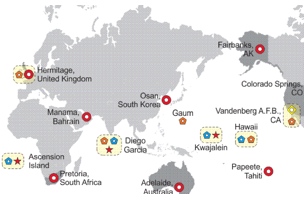There may soon be as many as 130 navigation satellites aloft. They will be from GPS, GLONASS, Galileo, BeiDou, QZSS, IRNSS and perhaps others. If so, the systems will provide users with quite a variety of signals and codes. The availability of many more satellites will enable new applications in areas where their scarcity has been a hindrance. For civil users, new signals will provide more protection from interference, ability to compensate for ionospheric delays with pseudoranges, and wide-laning or even tri-laning capabilities. There will be improvement in accuracy, availability, integrity, and reliability.
More satellites will be above an observer’s horizon.GPS and GLONASS together now provide the user with ~2 times the satellites than does GPS alone. If GPS, GLONASS and Galileo are considered together there will be ~3 times more. If BeiDou is added to the mix there will be ~4 times more satellites will be available to a user. In a sense, the more satellites the better the performance, particularly among trees and in urban canyons, those places where signals bounce and scatter and multipath abounds. For example, with the 6 satellites in a window available to a GPS receiver the user may be able to increase the mask angle to decrease the multipath and still have 4 satellites to observe. Imagine if there were 12, 18, or even 24 satellites and you can see how more satellites can mean better accessibility in restricted environments.
More satellites also means more measurements in shorter time and that means observation periods can be shortened without degrading accuracy in part because interference can be ameliorated more easily. With more satellites available, the time to first fix for carrier-phase receivers, the period when the receiver is solving for the integers, downloading the almanac and so forth, also known as initialization, will be shortened significantly. And fixed solution accuracy will be achieved more quickly. Today dual-frequency carrier-phase solutions are accurate but noisy, but with the new signals available on L2C, L5, and other GNSS signals, dual-frequency solutions will be directly enhanced.
The algorithms currently necessary for the achievement of high accuracy with carrier-phase ranging may be simplified since many of the new GNSS signals will be carrying a civilian code. Generally speaking, code correlation is a more straightforward problem than is carrier differencing. This may lead to less complicated receivers. This presents the possibility that they will be less expensive.
Also, the more diverse the maintenance of the components of GNSS, the less chance of overall system failure; the United States, Russia, the European Union, and China all have infrastructure in place to support their contribution to GNSS. Under such circumstances simultaneous outages across the entire GNSS constellation are extremely unlikely.
While a GNSS capable receiver may offer a user improved availability and reliability, it may not necessarily offer higher accuracy than is available from GPS. Recent improvements in the GPS Control Segment have improved the absolute accuracy available from autonomous (non-differentially corrected) GPS substantially. The Control Segment is comprised of government tracking and uploading facilities distributed around the world. These facilities not only monitor the L-band signals from the GPS satellites and update their Navigation Messages but also track the satellite’s health, their maneuvers, and many other things, even battery recharging.
Today there are 6 Air Force and the 11 National Geospatial-Intelligence Agency (NGA) monitoring stations. The monitoring stations track all the satellites, in fact every GPS satellite is tracked by at least 3 of these stations all the time. The monitoring stations collect range measurements, atmospheric information, satellite’s orbital information, clock errors, velocity, right ascension and declination. The new stations also improve the geographical diversity of the Control Segment and that helps with the isolation of errors, for example, making the distinction between the effects of the clock error from ephemeris errors. In other words, the diagnosis and solution of problems in the system are more reliable now because of the redundant observations of satellite anomalies with which to work. Testing has shown that the augmented Control Segment and subsequent improved modeling has improved the accuracy of clock corrections and ephemerides in the Navigation Message substantially and may contribute to an increase in the accuracy of real-time GPS of 15% or more.






